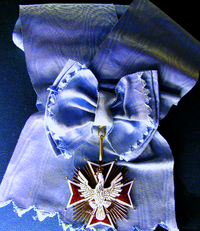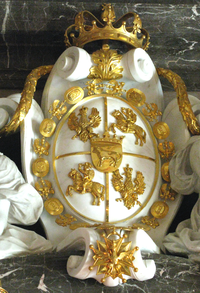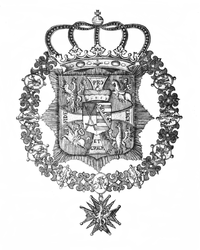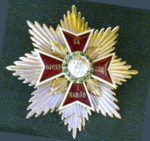- Order of the White Eagle (Poland)
-
Order of the White Eagle 
Awarded by Republic of Poland Type Single grade order Eligibility All Status Currently awarded Statistics Established November 1, 1705 Precedence Next (higher) none Next (lower) Order Virtuti Militari Related Order of the Garter 
The ribbon bar of the OrderCoat of Arms of Stanisław August Poniatowski with collana of Order of the White Eagle
The Order of the White Eagle (Polish: Order Orła Białego) is Poland's highest decoration awarded to both civilians and the military for their merits. It was officially instituted on November 1, 1705 by Augustus II the Strong and bestowed on eight of his supporters: four Polish magnates, three Russian field marshals (including Peter Lacy), and one Cossack hetman.
Contents
History
Royal Star of Order of the White Eagle of Augustus II the Strong before 1730
The badge Order of the White Eagle was originally a red enamel oval gold medal with an image of the Polish white eagle on its front side and bearing Augustus II's royal cypher over crossed swords on its reverse side worn on a light blue ribbon. This was replaced by a Maltese cross in 1709. By 1713 it was worn from the neck, with a blue sash, and a star. Although Augustus the Strong limited the number of knights to seventy-two, he only conferred the Order forty times before his death in 1733. His son, Augustus, however, awarded the Order more than three hundred times. Augustus may have been inspired to found the Order by the example of Peter the Great's recent founding of the Russian Order of Saint Andrew (of which he himself had been made one of the first knights by the Russian emperor), and above all by the example of the prestigious French Order of the Holy Spirit, with which the light blue ribbon, and the star with a bird, have a strong resemblance, and which had also inspired Peter the Great's Order of Saint Andrew. Initially the creation of the Order was strongly opposed by many of the Polish nobility since membership in the Order conferred a distinction which violated the traditional equality of all Polish nobles. Since the Order had no patron saint, Augustus II made August 2nd the feast of the Order. His son, Augustus III, however, changed the Order's feast day to August 3rd.
After the third partitioning of Poland, in 1795, the Order was abolished, though it was renewed by 1807 and became the highest award of the Duchy of Warsaw and of the Kingdom of Poland. It was also popular among the Russian czars, who also conferred the Order upon themselves. In 1830, after a November Uprising against Imperial Russia, to which Poland belonged at the time, the jewel of the Order was modified to more closely resemble those of Russian orders. It remained in this former until the Russian Revolution of 1917, in which the Russian Empire fell.
The Order of the White Eagle officially became Poland's highest decoration by act of Parliament of February 4, 1921, and the insignia was redesigned. In the interbellum the Order was awarded to 24 Polish citizens and 87 foreigners, among whom were 33 monarchs and heads of state, ten prime ministers and fifteen other ministers of state, and twelve members of royal families.
After 1948, when the People's Republic of Poland came into existence, the Order of the White Eagle was no longer awarded, but it was never officially abolished. It was also used by the Polish Government in Exile. Following the collapse of communism, the Order was once again reinstated on October 26, 1992, the Polish Government in Exile having already presented the seal and archives of the Order to Lech Walesa, first post-communist President of Poland. The first person to be awarded the White Eagle after its reinstatement was Pope John Paul II. The President of Poland is always the Grand Master of the Order.
1713 Insignia
1713 badge was a Maltese cross enameled red with white borders with diamonds set in each of the balls at the eight points of the cross and with diamond set rays appearing between each of the points of the cross, i. e., a larger longer ray between each arm of the cross and a smaller ray between each of the two points of these arms. In the center of the cross was a white enameled eagle in high relief with spread wings and facing left and with a diamond set royal crown on its head. At the top of the cross between the two top points was a diamond studded semi-circular link through which passed a diamond studded ring through which, in turn, passed the light-blue ribbon from which it was worn. The reverse side of this Maltese cross was enamelled white with red borders and had at its center an oval gold medallion with the founder's crowned royal cypher above two crossed swords taken from his arms as the Arch-Marshall of the Holy Roman Empire.
The star of the order consisted of an eight-pointed gold star with straight rays which bore a red-bordered white enamelled cross pattée with golden rays between the arms and with a golden rosette at its center. The arms of this cross pattée bore the motto "Pro Fide, Lege et Rege" (For Faith, Law and the King) in golden letters.
The King of Poland could also wear the cross from a collar of 24 alternative links of white enameled eagles, crowned and holding scepters and orbs and dark blue enameled ovals, surrounded by gold rays, bearing alternatively full-length enamelled images of the Virgin Mary crowned, dressed in pink and pale blue and supporting the Christ Child on her left arm and holding a gold scepter in her right hand and the letters of her name, "MARIA", arranged into a stylized monogram in white enamel. This collar was made for the coronation of Stanislaw August Poniatowski, the last King of Poland, but the coat of arms of the founder, Augustus the Strong, show the cross of the Order hanging from a collar of a very different design.
Insignia during the Tsarist era
The badge of the order consisted of a gold crowned double-headed eagle enamelled in black, with a cross superimposed upon its chest: this was a gold Maltese cross enamelled in red with white enamel outline and golden rays between the arms. A white enamel crowned eagle with spread wings, facing left (the coat-of-arms of Poland) was superimposed on the cross. On its reverse side the double-headed eagle bore in the center of its back a diminutive red-bordered white-enamelled cross pattée with a gold rosette at its center gold rays between its arms. The black double-headed eagle hung by its two crowned heads from an enamelled Russian imperial crown, which, in turn, hung from a dark blue silk moire ribbon.
The star of the order consisted of an eight-pointed gold star with straight rays; the central golden disc bore a red-bordered white enamelled cross pattée with a golden rosette at its center and golden rays between the arms, surrounded by a blue enamel ring bearing the motto "Pro Fide, Lege et Rege" (For Faith, Law and the King).
Insignia after 1921
The badge of the order consists of a gold Maltese cross enamelled in red with white enamel outline and with golden palmette-like rays between the arms. A white enamel crowned eagle with spread wings, facing left (the coat-of-arms of Poland) is superimposed on the cross. It is worn on a plain light blue sash. This design clearly reflects a return to the essential design of the 1713 badge, but without the diamonds of the earlier badge. The reverse side of the badge bears the same Maltese Cross with golden rays as the front side and this cross bears the same design as that of `the star of the order (see below), except that the arms of the cross are not enamelled red, i. e., only the outline of the cross and its central disc with its surrounding oak wreath are enamelled.
The star or plaque of the order consists of an eight-pointed silver star with straight rays, with a gold Maltese cross, enamelled in red with white enamel outline and with golden palmette-like rays between the arms, superimposed upon it. The motto of the order, „Za Ojczyznę i Naród” ("For Fatherland and Nation"), appears on the arms of the cross. The central disc is in white enamel with the monogram "RP" (Rzeczpospolita Polska) surrounded by a green enamelled oak wreath.
Knights of the Order
This is a list of some of those who have been invested in the Order, now awarded in recognition of significant service, both military and civil, in the interests of Poland.
See also
External links
- Further Reading on the history of the Order: The Order of the White Eagle by Rafal Heydel-Mankoo
- Picture of the Order of the White Eagle
Polish state orders, decorations, and medals Order of the White Eagle · Virtuti Militari · Order of Polonia Restituta · Order of the Military Cross · Order of the Cross of Independence · Order of Merit of the Republic of Poland · Cross of Valour · Military Cross · Cross of Merit for Bravery · Cross of Merit with Swords · Cross of Freedom and Solidarity · Cross of Merit · Military Cross of Merit with Swords · Air Force Cross of Merit with Swords · Navy Cross of Merit with Swords · Military Cross of Merit · Air Force Cross of Merit · Navy Cross of Merit · Medal for Sacrifice and Courage · Medal for Long Service · Medal for Long Marital Life · StarsCategories:- Order of the White Eagle (Poland)
- Awards established in 1705
Wikimedia Foundation. 2010.





